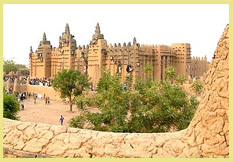




Deserts
 Deserts - shown in yellow on the map - cover almost 40% of the African continent. The Sahara stretches across from the Atlantic seaboard in the west to the Red Sea, creating a natural barrier between tropical Africa and the Mediterranean. This is a land of golden dunes, extraordinary rock sculptures and forbidding mountain fortresses, with some of the most inspiring landscapes on the continent. It is also a land of great fragility, in which ancient rock art and abandoned settlements consumed by sand tell of a bye-gone era of greater plenty. Yet, despite the lessons of history the advancing sands push southwards under the strain of mankind, and the last vestiges of life in the interior struggle for survival, against the odds. Two vast swathes of this wilderness are designated as world heritage sites - the Air and Tenere Natural Reserves in northern Niger and the Tassili N'Ajjer National Park in southern Algeria. The Sahara was once much wetter than it is today and water from rains that fell tousands of years ago lies in aquifers below` the sand - and in one extraodrinary site in northern Chad emerges from below to sustain a group of lakes - the Lakes of Ounianga - in the middle of the desert. Follow the links to learn more about these amazing places!
Deserts - shown in yellow on the map - cover almost 40% of the African continent. The Sahara stretches across from the Atlantic seaboard in the west to the Red Sea, creating a natural barrier between tropical Africa and the Mediterranean. This is a land of golden dunes, extraordinary rock sculptures and forbidding mountain fortresses, with some of the most inspiring landscapes on the continent. It is also a land of great fragility, in which ancient rock art and abandoned settlements consumed by sand tell of a bye-gone era of greater plenty. Yet, despite the lessons of history the advancing sands push southwards under the strain of mankind, and the last vestiges of life in the interior struggle for survival, against the odds. Two vast swathes of this wilderness are designated as world heritage sites - the Air and Tenere Natural Reserves in northern Niger and the Tassili N'Ajjer National Park in southern Algeria. The Sahara was once much wetter than it is today and water from rains that fell tousands of years ago lies in aquifers below` the sand - and in one extraodrinary site in northern Chad emerges from below to sustain a group of lakes - the Lakes of Ounianga - in the middle of the desert. Follow the links to learn more about these amazing places!
The Namib-Karoo deserts of southern Africa, although much smaller, support a much more varied flora with 50% of the 3500 species found nowhere else. A part of this smaller southern African desert - the Namib Sand Sea - was added to the world heritage list in 2013, recognising the unique features of this 'coastal fog desert' where animals and plants survive by catching atmospheric moisture from the fog. The extraordinary Welwitchia plant - with leaves looking like giant tattered ribbons lying in the sand - survives here.
The Ennedi Massif is a vast sandstone massif, covering some 30,000 km2 on the southern fringes of the Sahara Desert in eastern Chad. It is one of six major mountain blocks in the Sahara, all of which have been subject to major fluctuations in climate over millennia. The story of these changes is recorded in the area’s rich rock art, and evidenced by relict populations of plants and animals that survive in sheltered pockets in an otherwise desiccated environment.
Iconic Species: The deserts support some very special plants and animals, uniquely adapted to life in extremely dry conditions. In the Sahara there are about 1600 species of plant, 30% of them found only in the Sahara and neighbouring parts of the Arabian peninsula. Sadly, with the advent of modern motorised transport and firearms, the larger mammals of the Sahara have been relentlessly hunted in recent years and species like the addax, scimitar-horned oryx and barbary sheep have been exterminated from most areas, including the two world heritage sites.
Missing Links: Other outstanding areas in Africa's deserts deserve consideration as additional world heritage sites - including parts of the Namib Desert and the extraordinary Tibesti mountains in northern Chad.
.jpg)



